In this article, I will show you the two easiest ways to throw any size cast net. The first way works for any size cast net from 3-12 feet in radius. The second method is a fast way to throw small cast nets that have a 6 foot or smaller radius.
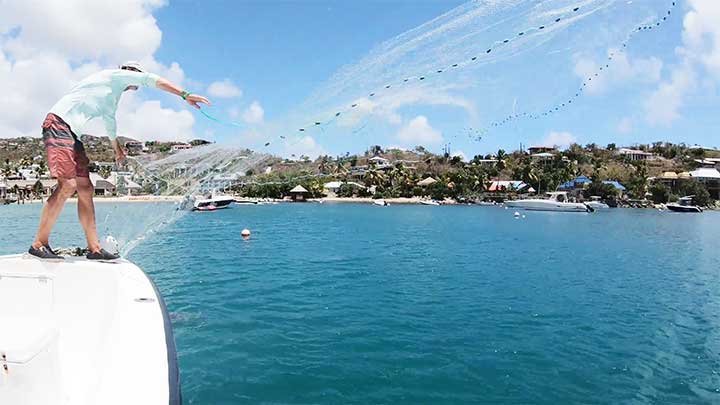
Throwing a cast net is one of the most useful ways to catch bait for fishing. It is also a fun activity for kids to do to catch fish and then let them go. Often times people get frustrated when the cast net does not open. With practice, throwing a cast net can be a fun activity. Cast nets range in size from 3-foot to 12-foot radius and are made by multiple companies. If you are looking to find the good cast check you the best cast net page.
How to Throw a Cast Net, Any Size, No Teeth, Stay Clean
1. Untangle the Cast Net
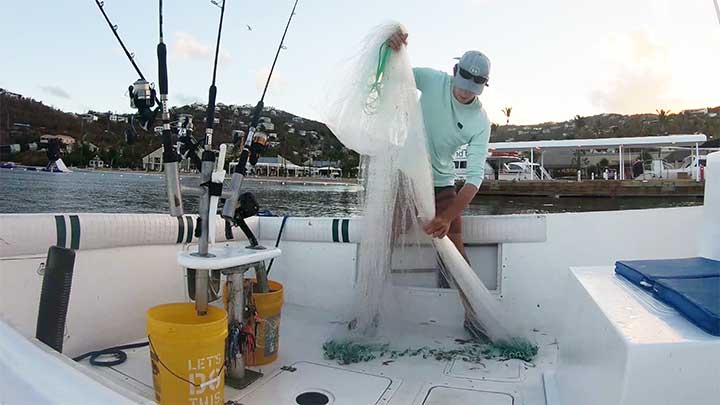
The most important step to throwing a cast net is to untangle the net. Some cast nets get more tangled than others. If the net gets caught in sticks and debris it will take more time to untangle. A quick and easy way to untangle the net is to pull 100 percent of the net from one side to another. If there are snags the net will not go from one side to another and will get caught. Typically just pulling had or lifting one side will work out the tangles.
The importance of untangling the net is often overlooked by people who throw cast nets. They assume the net does not open properly because of the technique. This could be the case but more often the net is just tangled and would not open properly for anyone who threw it. Sometimes the net does not even need to be untangled and other times it will take 2-10 minutes to properly untangle the net. If the net is old, torn, or beat up it is much more likely to tangle.
2. Coil the Cast Net Hand-Line
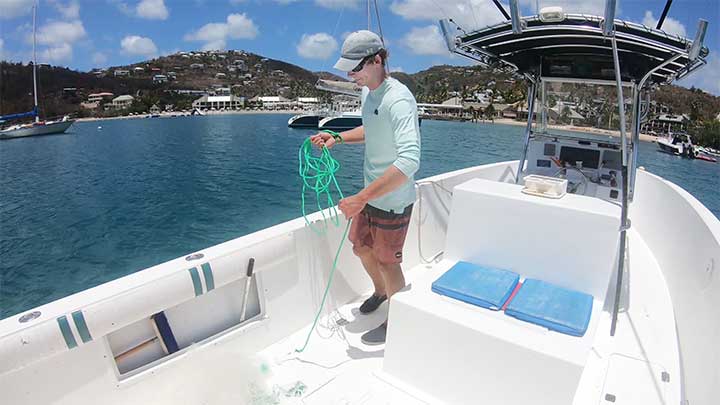
The hand-line should be coiled up just like wrapping up and extension cord. Make small wraps and place the rope in the right hand. If the rope is not properly secured it can get caught in the cast net resulting in the net not opening properly.
3. Straighten Out the Cast Net and Hold Under the Horn
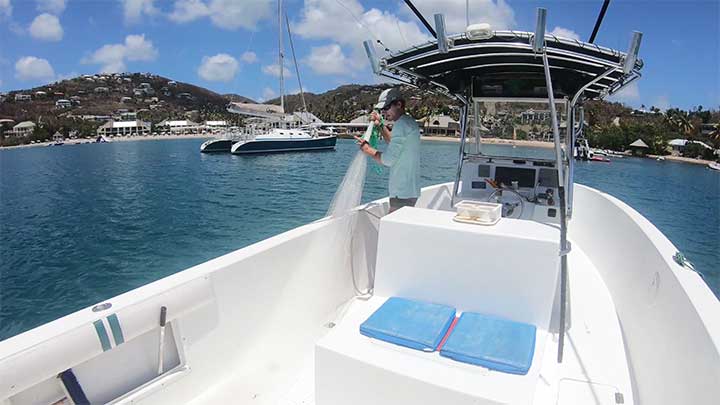
Next, the net is pulled into a straight line. The braille lines within the net are connected to the lead line and are what closes the net. These should be also be pulled completely straight. If these are staggered or twisted the cast net might not open or close properly. Grab the net close to the horn with the right hand.
4. Make Several Coils of the Net
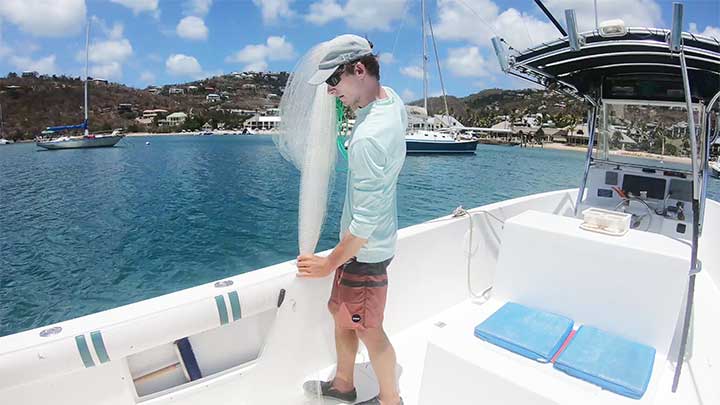
Wrap the cast net into several coils by collecting about one arm’s length of the net in each coil. Stop collecting when the net is about as tall as the person throwing the net. Grab the net at about the waist or hip level to make the final coil of the net. This makes the net a manageable size to pick up and throw.
5. Pull 1/3 of the Cast Net From the Front
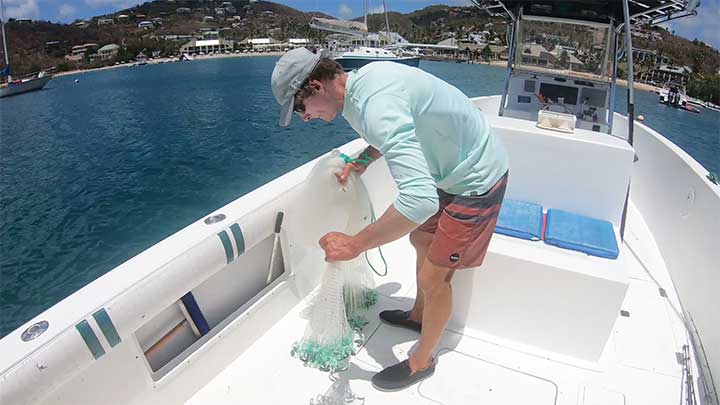
Starting from the left and pull out about 1/3 of the cast net. This is done by fanning the net and collecting it to ensure that there are not any tangles. Collecting the net this way is similar to how it was pulled from one side to another to untangle the net in step one.
6. Place the Collected Cast Net into the Right Hand
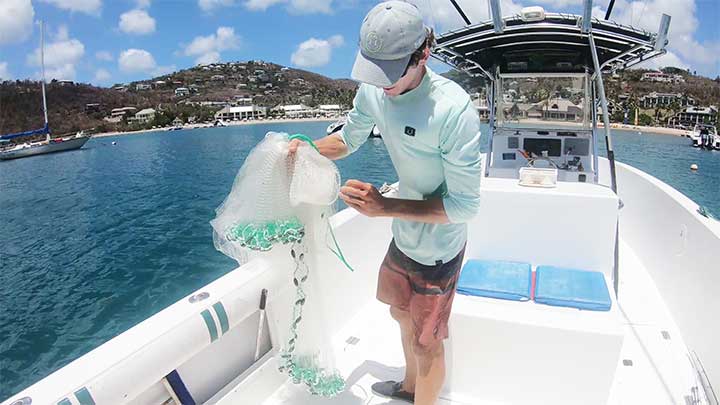
Next, take the collected net and place it in the right hand with the rest of the coiled net. At this point, there are two sections of the net a high section and a low section.
7. Take the Lead Line and Put it in the Right Hand
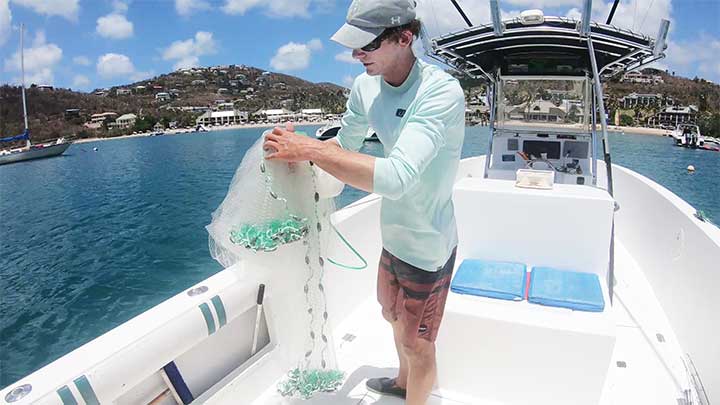
Grab the lead line the starting from the low section of the cast net. Place the line into the right hand. This helps to start opening the net right away.
8. Collect 10 Percent of the Remaining Lead Line
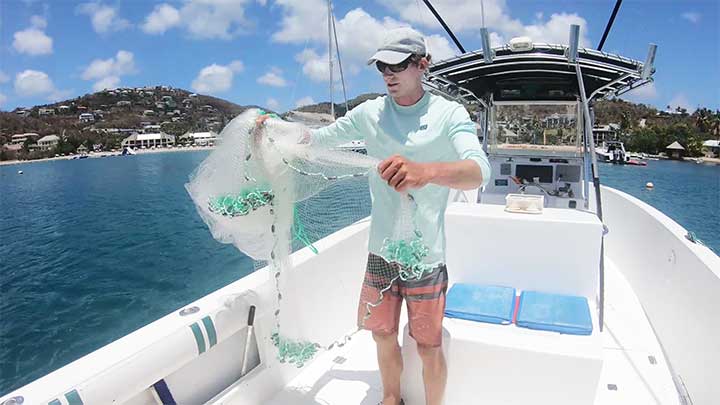
Next, pull about 10 percent of the net from the lower section of the net. This further separates the net and makes it easier to throw. If the net is under 6 feet this step will not really be needed. For large cast nets, this makes it more manageable to throw.
9. Swing the Net Back and Focus on the Bait

Swing the cast net back towards the rear. This loads the net and your muscles to act as a spring to allow the net to be thrown forward with lots of force. Watching the bait is very important just to ensure proper net placement. With large cast nets, it is going to open directly in front of you so make sure that is where the bait is located. If you throw to early or late it does not matter how good the opening is because no bait is there to be caught. Patience and good timing often work better than lots of casting.
10. Trow the Net Forward with the Right Hand

At first, it seems strange that just throwing the net forward will make such a large net open. How the cast net is wrapped allows the weights to spread out during the throw. If the net has any tangles it can become snagged and does not separate properly during the throw. Also, heavy side winds can cause a partial opening. In heavy winds, it best to throw with the wind. Sometimes the baitfish do not cooperate though.
11. As the Net Spreads Out Pull Back with the Left Hand
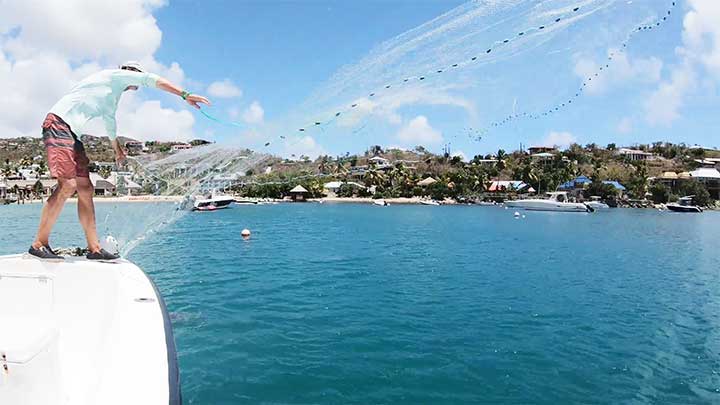
After throwing the forward with the right hand pull back with the left hand. This happens quickly and once you throw more and more it becomes a habit. Hold onto the net with the left hand a pull it across your body. As the net drops, it pulls on the left hand a bit harder and that is a good time to release. This action allows the weights to separate and open the net.
12. Let the Cast Net Sink to the Bottom
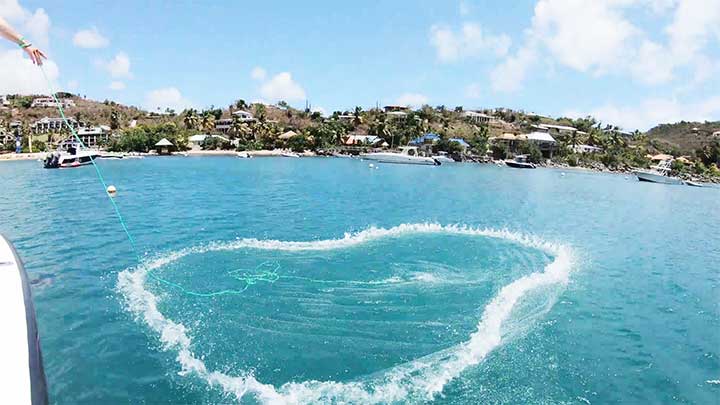
Once the cast net is in the water the lead weights allow it to sink. Depending on the amount of weight and size of mesh determine how fast the cast net sinks. Smaller mesh size will cause the net to sink slower because of the extra drag. In most cases you want the net to sink all the way to the bottom. If the bait is near the surface and the bottom structure is not known the net can be closed before it hits the bottom. Do not just pull the net up quickly though because it will lift while closing and the bait can escape out the bottom. Make short tugs and let the net sink again so the bait can not escape. Once you think the net has closed it can then be quickly retrieved.
13. Make Short Tugs on the Hand-Line
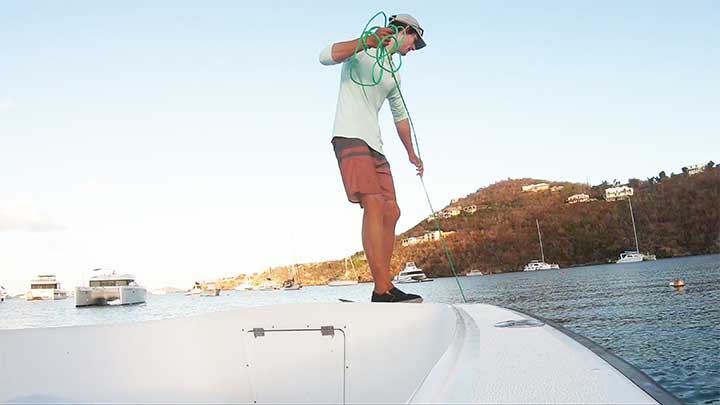
Once the net stops sinking the slack in the line should be collected. Make short little tugs while slowly pulling the net up initially. This allows the net to close without actually lifting the net off the bottom. The cast net will also catch any other items on the bottom as well like rocks, coral, sticks, and seaweed.
After throwing the net in the area you become familiar with the bottom structure. Some bottoms like sand and dirt allow the net to easily closed on the bottom. In other places, the net might get snagged and even tear while pulling it up. When throwing in a new place I am cautious at first and might even throw a smaller net that is less likely to get stuck on the bottom. If it is stuck you can always jump in and untangle it. From shore, this is easier than when on a boat.
14. Once the Net is Closed Pull Bait to the Surface
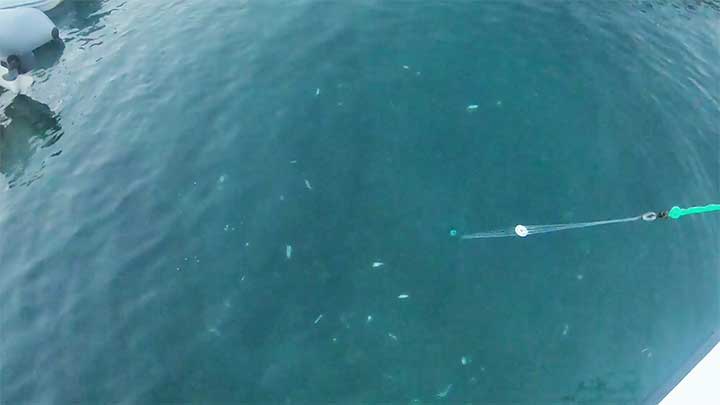
When you see flashes in the net when it is sinking there is a good chance you caught the bait. Often times you can even feel vibrations in the hand-line from fish hitting into the net. In the picture above the net is closed and you can see all the pilchards that are trapped in the net. This is what you want to see when you make a good throw. If there is not flashing then the chances are very little bait was caught.
Some days bait is difficult to catch and even a few baits will be kept from a bad cast. Other days, if lots of baits are not caught then the net will be emptied out into the water to save time. Ideally, all the bait for the day can be caught in one good throw. Usually, at first light the bait is most active near the surface where it can be easily spotted and caught.
15. Allow the Net to Drop Slightly Collecting the Bait in the Cast Net Pockets
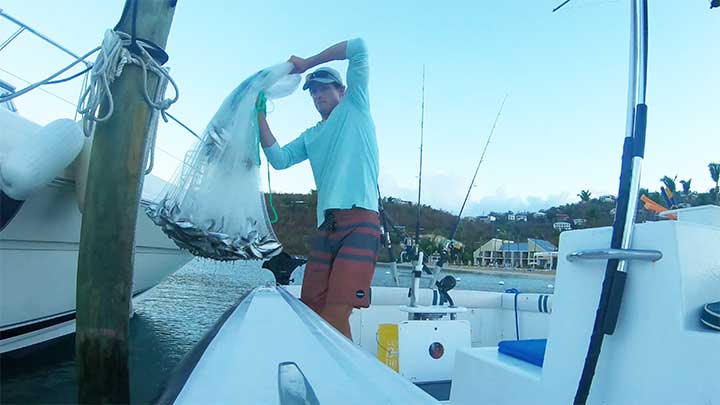
When a lot of bait gets caught it can actually be difficult to bring in and put into the livewell. When the lead line is almost out of the water you want to do what is called dropping the net. This is done by opening the grip on the net so it slides through your hands for a second. It feels like a bad idea at first like the net might open and the bait will escape. However, it just allows a pocket to form when the bait will collect. This makes the bait easier to transfer into the livewell.
16. Empty the Bait into a Livewell
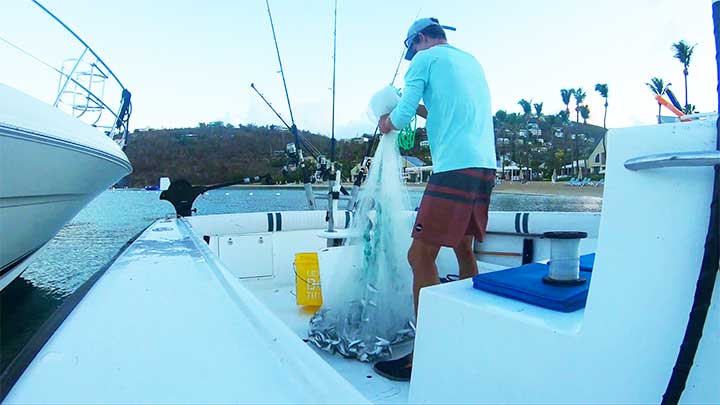
To empty then net open the grip on the net allowing the braille lines to slide down. This opens the bottom of the net so the bait will fall into the livewell. Lift the net high and make sure to shake out any bait that might be stuck. When the bait storage location is elevated it can be difficult to empty the net directly into the tank. If this is the case, having a large bucket or basket to empty the bait into is nice. The bait can then be easily transferred to the livewell.
For more information about particular types of cast nets, check out the best cast net page.
17. How to Throw a Cast Net Video Demonstration
The video above shows how to throw a cast net. It is the same method described above. It takes some practice to get good at throwing a net. With time users become faster and untangling, loading, and throwing the cast net.
It is best to start with a cast net under 8 feet in diameter to become proficient at the basics of throwing a net. The main problem I have seen people have when learning to throw a net is letting the net get tangled. With a bad throw, the net is more likely to get tangled so the whole process becomes more difficult. Also, make sure you are holding the net in the right hand. Some cast net throwing methods have the user swing the net from the left hand. As a right-handed person, I feel it is much more natural and easier to throw with the right hand.
How to Throw a Small Cast Net
1. Hold the Net Near the Cast Net Horn
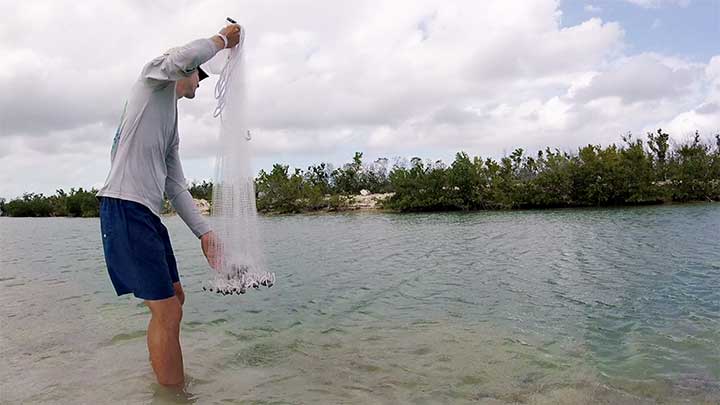
Hold the cast net near the horn with the right hand. If the cast net is shorter than you it can be grabbed right at the horn. If not grab a foot or two below the horn.
2. Grab the Lead Line Near the Base of the Cast Net
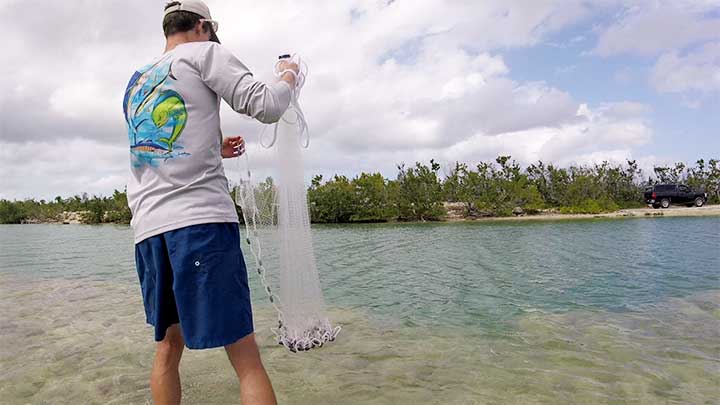
Reach down and grab the lead line that is closest to you with the left hand. In the right hand hold the coiled rope and the top of the cast net.
3. Place the Lead Line Over Top of the Net
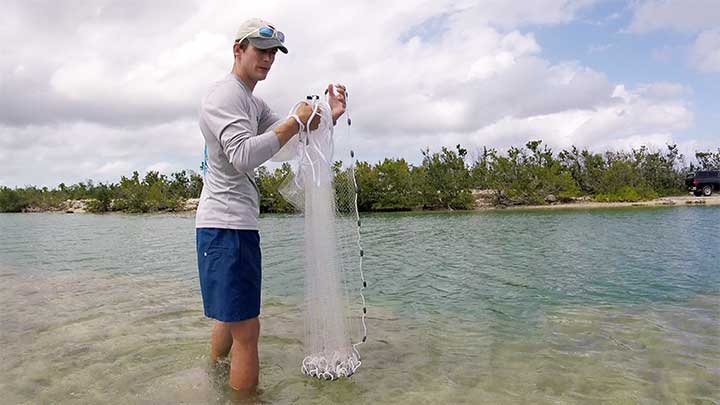
Next, the lead line is going to be placed over the horn of the cast net.
4. The Lead Line Goes Over Top of the Horn
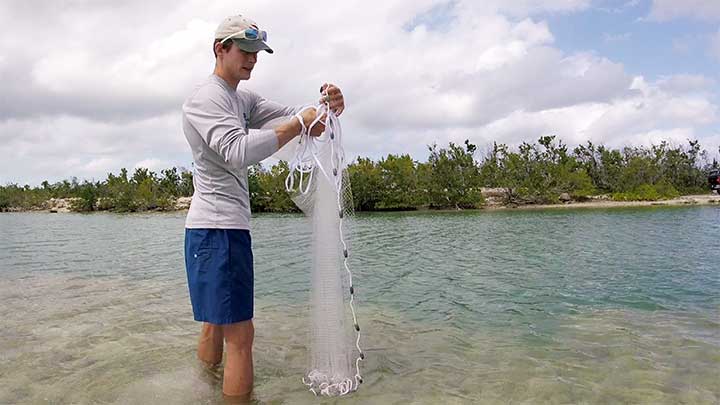
Place the lead line around the horn and then pinch it with the thumb. There is an easy throw cast net that has a large ring for the lead line to be placed in. This is using the same method. However, there is not a metal ring. Without the ring, it is actually easier to throw.
5. Hold Several Feet Down with the Left Hand
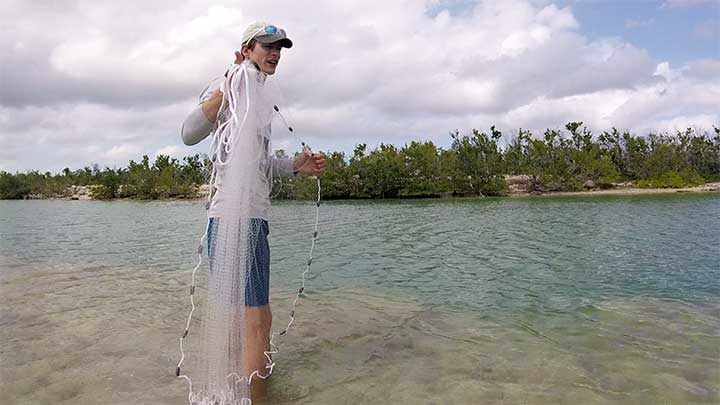
With the left-hand reach hold the net about two feet away from the horn.
6. Swing Back and Focus on the Bait
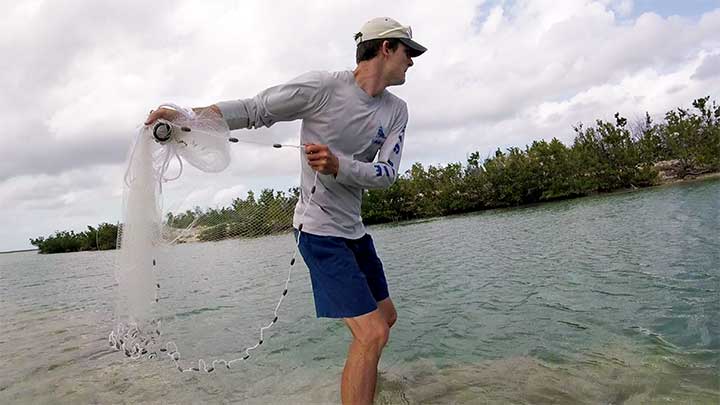
Swing the net back and look for where the bait is located. This is a small net and should be cast just in front of the bait in the direction that they are swimming.
7. Throw Forward with the Right Hand and Pull Back with the Left Hand
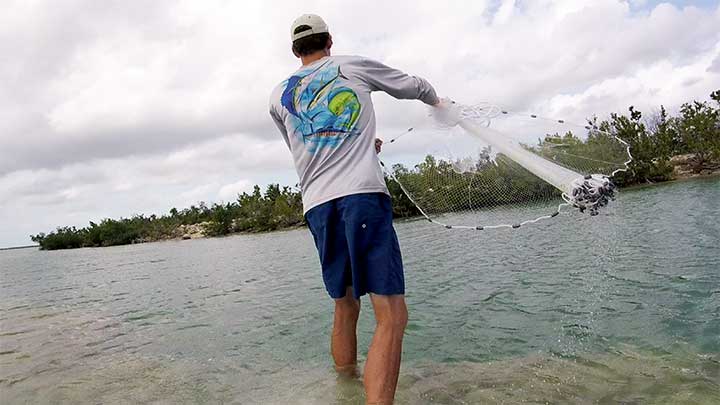
Bring the right arm forward and throw the net hard. Pull the left hand back and across the body. Let go of the net with the left hand last, slightly after the main net has been released.
8. Retrieve the Cast Net and Collect the Bait
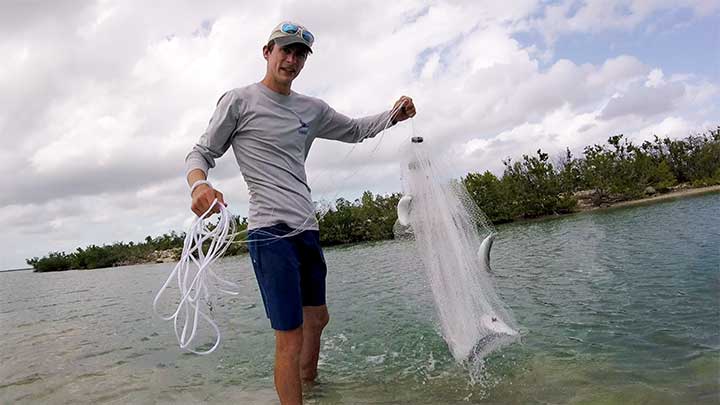
When the cast net hit the water let it sink. Then make short tugs to close the cast net. Pull the net the rest of the way in and see what is caught. Grab the horn and let the net slide down the braille line to open the net and release the bait. The mullet video below shows several demonstrations on how to trow a small net using this cast net throwing method.
The best cast net page has more info about cast net types and sizes. The size of the net, mesh size and weight per foot are all important items to consider when selecting a cast net. The general rule of thumb is that for big baits a large net with a wider mesh size is best. For small baits, a small mesh size is needed.
Fish that are commonly caught with live or fresh bait include hybrid striped bass, striped bass, mahi-mahi, sharks, tuna, and tarpon.
How To Catch Mullet with a Cast Net
Mullet are often thought of as one of the hardest baitfish to catch with a cast net. This is because there are often found in deep clear water. The cast net needs to be large and sink fast to catch mullet under these conditions. Buying a large radius net with a large 1 1-4 inch mesh makes it so mullet can be caught in deep clear water.
Another trick is to catch mullet in shallow water or when they are near the surface. If you watch the water closely you can often see mullet swirling near the surface. The net has to be thrown in front of the mullet. Often the mullet can see the net coming and swim fast out the net when it is thrown directly on top of their current position. However, by leading the bait they can be caught.
How To Catch Bunker with a Cast Net
Bunker is another baitfish that can be difficult to catch with a small net. A large fast sinking net is important with catching bunker. If peanut bunker are located near shore they can be caught like other small baitfish. However, in deep water, other strategies need to be used. It is common to see schools of bunker boiling near the surface. If the cast net is thrown on top of the bait the splash spooks the fast-moving bait and the fish can often avoid the net completely.
The trick is to slowly back of the bait school with the boat. This sends the bait deep. Once the bait is located on the fish finder the net can be thrown. In this case, the bait is not spooked by the splash. The large cast net will slowly sink over the bait in the murky or stained water. This results in a large number of the bunker being caught in one throw.
Frequently Asked Questions
How does a cast net work?
A cast net works by having a single person throwing a 4-12 foot radius net into the water. Lead weights around the perimeter of the net allow the net to sink in the water. Braille lines are connected to a hand-line and when pulled it closes the net. Bait can be caught in water ranging from 1 foot deep to over 20 feet deep. Game fish can not be kept if they are caught in a cast net. The intention of a cast net is to catch live baitfish.
How do you throw a cast net perfectly?
The are multiple ways to throw a cast net. The triple load method is a common way to throw a large cast net. However, with this method, the net needs to be placed on the body. After the first throw, the net is wet and it is not an enjoyable way to throw a net. The method described above is the easiest way to throw a large cast net. There is also the easy throw method described above that works great to throw small cast nets.
For a perfect cast net throw, the net should be loaded fast. The method should not require the net to be placed on the person and teeth should not be needed to hold the net. When throwing the net should open fully in a round circle. This is often called throwing a pancake. The net should be in a position to catch the most bait. Sometimes this is directly over the fish and sometimes the net should be placed in front of where the fish are moving. When the net sinks it should trap all the bait. The net should close without lifting so that bait does not escape out the bottom. The bait should be quickly transferred into a livewell.
What size cast net is best?
There are two sizes that are important when selecting a cast net. First is the radius of the cast net. Which size cast net is best depends on the user’s abilities, and the type of fish being targeted. A 3-foot radius net is the smallest cast net. That size is made for kids. For adults, a 4-foot radius would be the smallest net you would likely want. A 12-foot net is good charter captains that want to quickly catch lots of bait for the entire day. Most people are best off getting a net that has between a 5-10 feet radius.
Next is the mesh size which ranges from 1/4 inch mesh to 1-1/4 inch square mesh. Most mesh sizes given are in terms of square mesh. For example, a 3/8-inch square mesh is 3/4 inches when stretched. Another example is 1-1/4 square mesh is 2-1/2 inch when stretched. The most common mesh size for cast nets is 3/8 inch square mesh. This works well for catching baits that are 2-6 inches in length. The best cast net page has a list of the many types and sizes of cast nets.
What are the methods to throw a cast net?
The best methods to throw a cast net are the triple load method, the Percy method, and the method described above. These all work great for throwing large nets with a radius over 7 feet. For smaller nets, under 6 feet the easy throw method also described above can be used.
How much does a cast net weigh?
An average cast net weighs 1 pound per radius foot. That means that a 6-foot cast net would have 6 pounds of lead or steel weights. The netting material and hand-line weight are not included in that weight but these only make up about 10 percent of the total weight of the cast net.
The heavier the cast net the faster it will sink for the given mesh size. Most steel weight cast nets have about .75 pounds of weight per radius foot. Some custom nets have 1.5 pounds of lead per radius foot. Personally, I like nets that have 1-1.3 pounds of lead per radius foot when throwing in deep water. In shallow water, less than 2 feet deep the weight of the net is not as important. Sometimes a lighter net is nice since it can be thrown far and results in less fatigue when throwing it over and over to try and catch bait.
Captain Cody has worked on charter fishing boats in the Florida Keys, Virgin Islands, and Alaska. Growing up in Pennsylvania Cody has also done extensive freshwater fishing including bass fishing tournaments. Cody strives to provide detailed information about the best fishing gear and tactics to help both novice and experienced anglers have a more productive and enjoyable time on the water. Cody also has a background in aerospace engineering and neuroscience but really only takes pride in being good at one thing and that is fishing!

I just ordered my first cast net thanks to you. It’s a Bait Buster Pro 7 Foot 3/8″ mesh. I will mainly use it to catch minnows up in Northeast Ohio , and Northwest Pennsylvania. I thank you very much for being here and doing what you do, so that I can learn the correct way to throw a cast net. Have a great day today and every day. I will try to remember to take some photos for you to see how well I learned to throw a cast net from you. My son and I are going to Presque Isle in the morning for smallmouth bass, pike, and whatever else wants to bite. Stay safe!